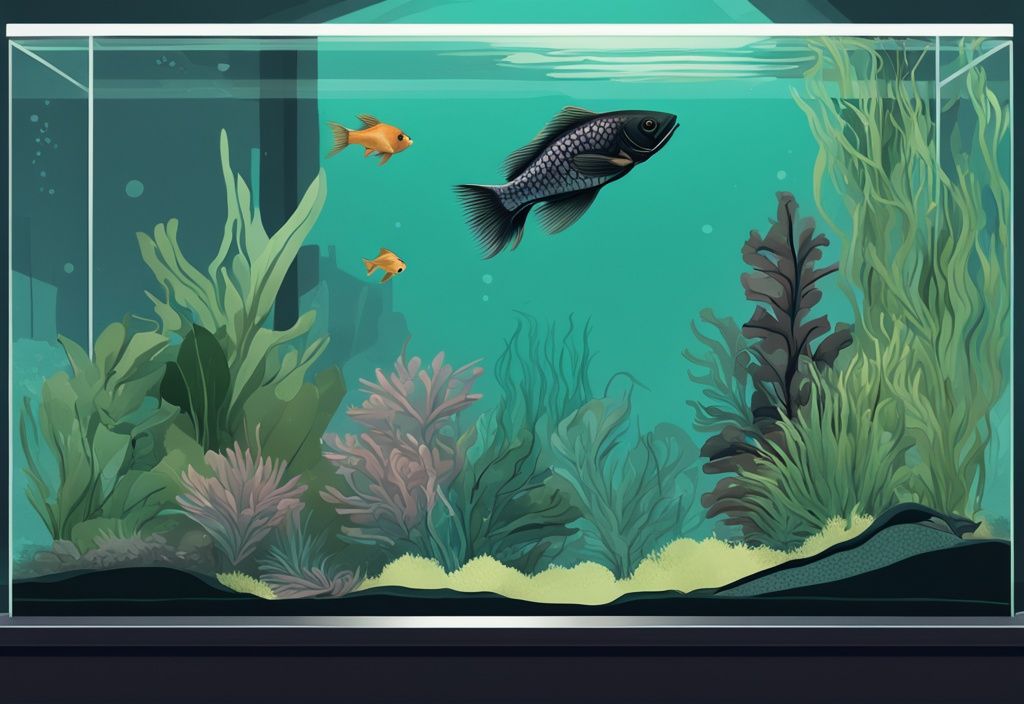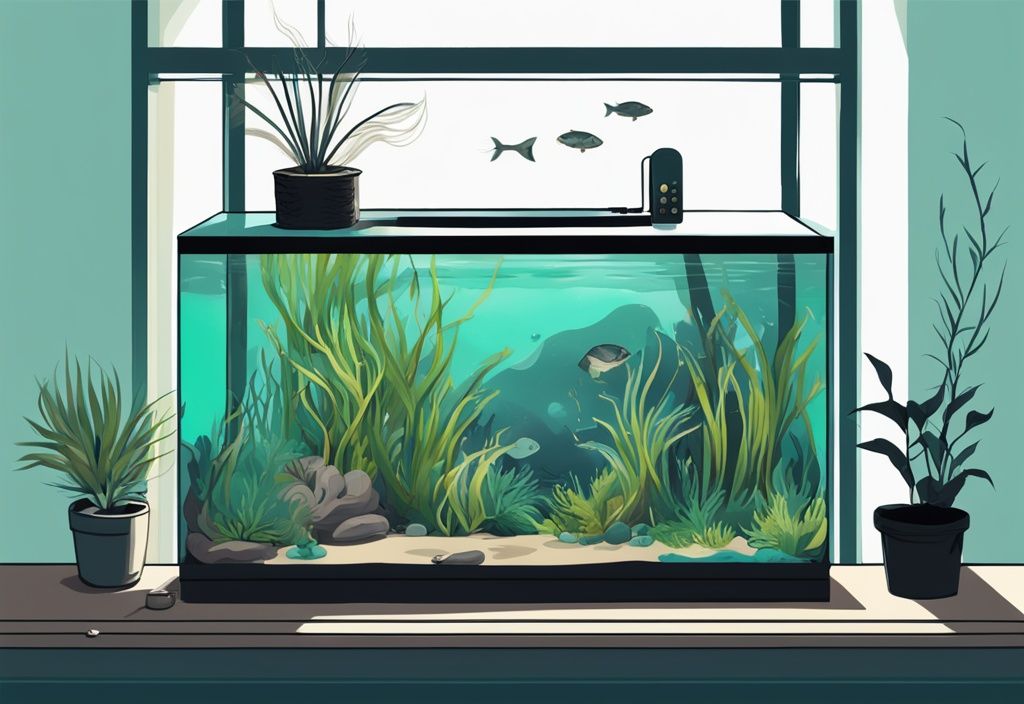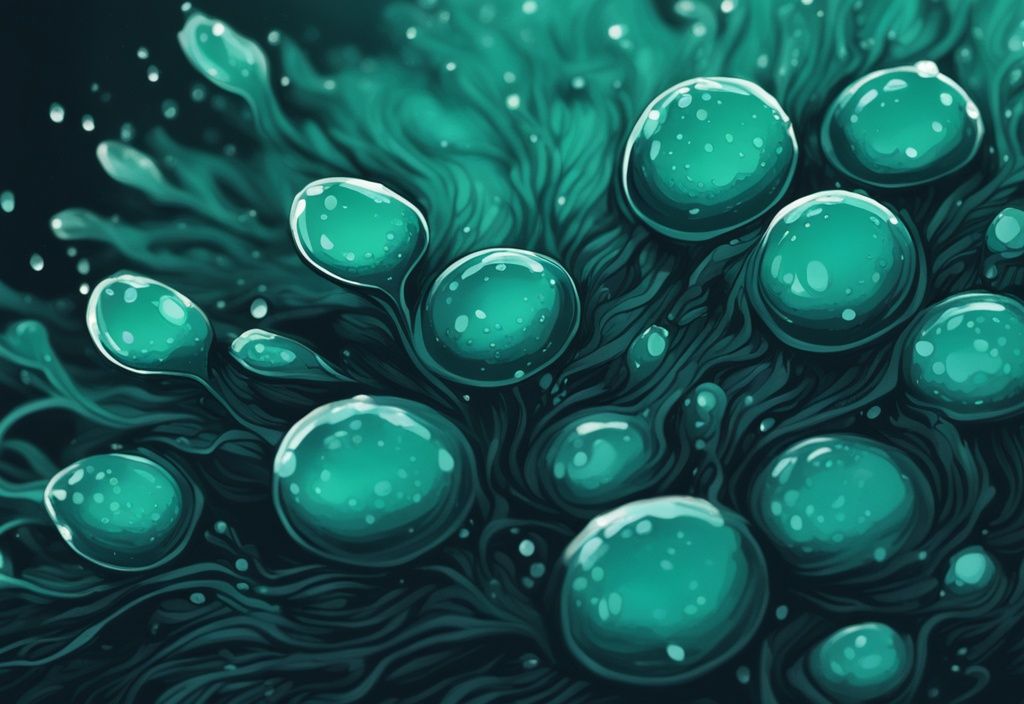Have you ever awoken to find your cherished aquarium overrun by a grizzly intruder – black beard algae? With a tenacity that rivals its pirate namesake, this formidable foe runs rampant in aquariums, detracting from their splendid allure. Fear not, fellow aquarists! My years observing marine ecosystems lend me the know-how to help you combat this algae adversary.
In this guide, you’ll uncover the secrets of identifying, preventing, and annihilating black beard algae. From deciphering its earliest signs, devising preemptive strikes, to implementing effective elimination tactics, we’ll navigate these murky waters together.
So, why not equip yourself with the knowledge to restore your aquarium’s radiance? Unmask the curiosity within you and let’s journey together into these waters – turning the tide against black beard algae once and for all. Like an expert captain steering her ship, let’s reclaim the pristine beauty of your aquarium!
A Closer Look at Black Beard Algae
Understanding Black Beard Algae (BBA) is essential for aquarium enthusiasts who wish to maintain a pristine and healthy aquatic environment. This section delves into what BBA is and how to identify it in your tank.
What is Black Beard Algae?
Black Beard Algae (BBA), also known as Black Brush Algae, is part of the red algae family and falls under the genus Audouinella. This algae often makes its home in freshwater aquariums, thriving under certain conditions that require careful management.
The coloration of BBA varies, displaying hues from black to dark green or even dark red depending on the environment. One unique aspect of BBA is its ability to use hydrogen carbonate as a carbon source, which can raise pH levels in the aquarium. This characteristic potentially influences the overall balance of your tank and affects the health of its inhabitants.
The Appearance and Identification of Black Beard Algae
Identifying BBA in your aquarium revolves around its distinct appearance. This algae often appears as dense, bushy tufts clinging to the edges of plants, driftwood, stones, or other decorations. These tufts are especially notable in areas of high water flow but can also be found in more stagnant places.
The algae’s fine, hair-like structures, typically black or extremely dark in color, resemble a beard—hence the name. Observing these characteristic tufts, particularly in high-flow areas, can help aquarists quickly pinpoint and combat BBA.
By familiarizing yourself with these unique traits and behaviors of Black Beard Algae, you can take proactive steps to manage and mitigate its presence. This approach ensures a healthier and visually appealing aquatic environment.
Why is Black Beard Algae in Your Aquarium?
Understanding why black beard algae (BBA) appears in your aquarium is crucial for preventing its growth and maintaining a healthy aquatic environment. Various factors contribute to BBA proliferation, and addressing these can help you maintain a balanced tank.
Common Causes of Black Beard Algae
Black beard algae is often a signal that something is amiss in your aquarium’s ecosystem. One primary cause is an imbalance due to excess nutrients and suboptimal water quality. Elevated levels of nitrates and phosphates, key nutrients for plant growth, inadvertently promote the proliferation of BBA.
Additionally, fluctuating or low levels of CO2 in the tank can create an environment conducive to BBA growth. Poor maintenance practices, such as infrequent water changes, exacerbate these issues. When fish are overfed, the leftover food decomposes, releasing organic waste and amplifying nutrient levels in the tank. This not only feeds the algae but also degrades water quality.
A similar situation arises when organic waste builds up in filters and substrates, providing a nutrient-rich environment perfect for BBA to thrive. It’s like setting up a buffet that BBA just can’t resist, leading to a quick takeover of your beautiful aquarium scenery.
How Nutrient Overload and Water Quality Impact Algae Growth
Nutrient overload in your aquarium, particularly with nitrogen compounds like nitrates and phosphorus compounds like phosphates, acts like a fertilizer for black beard algae. These excess nutrients disrupt the natural balance of the tank, making it an ideal habitat for BBA. Poor water quality often mirrors this nutrient overload, as high levels of nitrates and phosphates signify underlying issues with tank maintenance.
When organic waste accumulates, it not only contributes to poor water conditions but also creates a breeding ground for BBA. Regular testing of water parameters is crucial to detecting these imbalances early on. By frequently monitoring the levels of nitrates, phosphates, and CO2, aquarists can identify and rectify the factors contributing to BBA proliferation before it becomes a significant issue.
Think of your aquarium as a microcosm that requires balance and mindfulness. Regular water changes, avoiding overfeeding, and ensuring efficient filtration are steps that can prevent nutrient overload. Regular water parameter tests are akin to frequent health check-ups for your tank, enabling you to nip potential problems in the bud.
By addressing these underlying factors, you can create a thriving underwater world where both plants and fish flourish, free from the invasiveness of black beard algae.

Preventing Black Beard Algae
Importance of Regular Water Testing
Consistently testing your aquarium’s water is essential to prevent black beard algae. By regularly monitoring the levels of nitrates and phosphates, you can identify and rectify any imbalances before they become problematic. For instance, maintaining nitrate levels below 40 ppm is crucial to inhibit BBA growth. Water testing also allows for the early detection of quality issues that might otherwise foster an environment conducive to BBA proliferation. Moreover, maintaining stable CO2 levels is vital, as fluctuations can create favorable conditions for BBA. Regular testing ensures all these parameters remain within the optimal range, providing a healthier environment for your aquarium inhabitants.
The Role of Lighting and Filtration in Algae Control
Effective lighting management is a cornerstone in preventing black beard algae. High-intensity lighting for prolonged periods can accelerate BBA growth, so it’s important to establish a consistent lighting schedule and consider reducing light intensity when necessary. Equally important is the role of filtration. Strong and well-maintained filters enhance water circulation, minimizing stagnant areas where BBA can thrive. Regularly cleaning filters is crucial to prevent the accumulation of organic material that not only contributes to nutrient build-up but also serves as a potential breeding ground for BBA. When both lighting and filtration are properly managed, they create a balanced environment less hospitable to black beard algae.
Optimize the content with the following guidelines:
1. The content should be written by a fictional persona, to make it sound humanized. Adapt the writing style to match the persona’s perspective and make the content sound human-like: Dr. Melanie Rivers, a seasoned marine biologist with over 20 years of experience, writes with an insightful blend of expertise and warmth. Her style is meticulously detailed yet exceptionally approachable, transforming complex marine science concepts into clear, actionable advice. She employs a narrative that exudes passion and dedication, making technical information easily digestible. Dr. Rivers uses analogies and relatable scenarios to explain intricate topics, ensuring a deep understanding. Her tone is professional but welcoming, often peppered with personal anecdotes and a touch of humor to make the content engaging. She values sustainability and emphasizes creating balanced ecosystems in aquariums. Her unique approach lies in her ability to humanize scientific jargon, fostering a sense of confidence and curiosity in her readers, making them feel both informed and inspired.
2. Ensure that new paragraphs are being used regularly, so the content is easier to read.
3. Ensure heterogeneous sentence length.
4. In case an H2 has no content: Provide the H2 heading with content which introduces what is being covered in its subheadings. Do not greet the reader or talk about yourself in the H2 introduction.
5. Use “Du” instead of “Sie” when talking to the reader
7. Use HTML format for all content creation like for example:
,
- ,
- , etc.
8. Only optimize the Content, do not change anything else. Do not add “Optimized Content:” in front of the optimized content.
9. Do not greet the reader or introduce yourselfProject Details:
Project: Fishtankzone.com is a comprehensive blog dedicated to aquarium enthusiasts, offering expert guides, product reviews, and practical tips for maintaining vibrant fish tanks, catering to both beginners and experienced aquarists with clear and concise information.
Language: English
Important: Do not copy these guidelines into the output. Just rework the given Content with the mentioned guidelines
Getting Rid of Black Beard Algae
Black beard algae (BBA) can be a persistent nuisance in aquariums, affecting plants, decorations, and the overall aesthetics of your tank. Tackling BBA requires a multifaceted approach, blending manual methods, biological solutions, and, if necessary, chemical treatments to ensure a thriving and balanced aquatic environment.
Manual Removal Techniques You Can Try
Manual removal is a primary and effective approach to combating black beard algae in your aquarium. Regularly trim and remove affected plant leaves to prevent BBA from spreading. By doing this, you reduce the amount of algae available for future growth. Additionally, take out and clean any infested decorations or aquarium decor items. Tools like toothbrushes prove especially useful for scrubbing off BBA from hard surfaces such as rocks and driftwood, providing a more precise and thorough cleaning.
Imagine meticulously brushing the fur of a beloved pet—it’s the same care and attention you give when using tools to remove BBA. Regular maintenance is like grooming your underwater garden, preventing the algae from taking over.

How Algae-Eating Species Can Help
Introducing algae-eating species to your aquarium can significantly help in controlling BBA. Species such as Siamese Algae Eaters, Florida Flagfish, Amano Shrimp, and Nerite Snails are highly effective natural solutions. These creatures feed on BBA, helping to keep its growth under check and providing a balanced ecosystem within the tank.
This method is like inviting a team of dedicated housekeepers into your aquarium—each species takes on the role of natural algae control, reducing the existing BBA and preventing future blooms. It’s a sustainable and eco-friendly option, maintaining harmony and health in your aquatic world.
When to Use Chemical Treatments
Chemical treatments should be considered as a last resort for severe BBA infestations. Spot treatments with liquid carbon additives, hydrogen peroxide, or specialized algae removers can be effective, but must be applied with caution. These chemicals can have adverse effects on tank inhabitants if not used correctly.
Always ensure that the products are safe for your specific aquarium species to prevent any unintended harm. Begin with small doses, monitor the effects, and make adjustments as necessary. Think of it as administering medicine—careful, precise, and always mindful of the well-being of your aquatic friends.
By addressing BBA through these varied strategies, you can restore balance and beauty to your aquarium, creating a healthy and thriving environment for all its inhabitants.
Aquarium Maintenance to Keep Black Beard Algae at Bay
Creating a balanced and vibrant aquarium environment requires dedicated effort, especially when dealing with persistent issues like black beard algae. This section delves into effective maintenance strategies, focusing on regular trimming, cleaning, and organic waste management.
Guidelines for Regular Trimming and Cleaning
Regular aquarium maintenance is essential for preventing the spread of black beard algae. Conducting weekly 50% water changes helps maintain optimal nutrient levels and eliminate potential BBA spores from your tank. Old and affected plant leaves should be trimmed regularly since these can be prime locations for algae growth.
Additionally, a thorough cleaning routine for the substrate and decorations ensures minimal organic waste build-up, which in turn helps to deter the proliferation of black beard algae. Effective maintenance goes beyond just water changes and plant care.
Ensure that all surfaces within the tank, including rocks, driftwood, and other decor, are periodically scrubbed. This prevents BBA from establishing itself on these materials. Investing time in these weekly cleaning practices not only helps in keeping black beard algae at bay but also promotes the overall health of your aquarium environment.
Managing Organic Waste to Prevent Algae

Managing and reducing organic waste is crucial in preventing black beard algae. Regularly vacuuming the substrate is necessary to remove debris and decomposing materials that can lead to nutrient spikes, as such spikes often create an ideal breeding ground for algae.For those looking to supplement their cleaning routine, introducing the best tank cleaning fish can be beneficial.
Besides substrate cleaning, maintaining stable CO2 levels is of utmost importance. Stable CO2 levels, coupled with proper water flow, help mitigate environments where BBA can thrive.
Overfeeding fish is a common cause of excessive organic waste. Ensure to feed your fish in moderation and promptly remove any uneaten food to prevent it from decaying and contributing to nutrient overload. Effective waste management is a holistic task that involves regular care, including proper feeding practices and scrupulous substrate cleaning.
All these actions collectively foster a balanced ecosystem, keeping black beard algae under control and ensuring a healthy and vibrant aquarium.
FAQ
What are the main causes of Black Beard Algae in an aquarium?
Black beard algae, often a bane for aquarists, thrive in conditions with excess nutrients, poor water quality, fluctuating CO2 levels, overfeeding, and inadequate maintenance practices. Think of your aquarium like a finely tuned orchestra—every element from the water quality to nutrient levels must be in harmony. A little imbalance, and the unwelcome BBA can take center stage.
How can I effectively get rid of Black Beard Algae?
Addressing black beard algae demands a holistic approach. Start with manual removal; a gentle scrub can dislodge these tenacious invaders. Introduce algae-eating species to your tank, adjust lighting and filtration settings to maintain favorable conditions, and resort to chemical treatments only when absolutely necessary. Persistence and consistency in these efforts will turn the tide in your favor.
What are the best algae-eating species for Black Beard Algae control?
Some aquatic helpers can aid in the battle against BBA. Species such as Siamese Algae Eaters, Florida Flagfish, Amano Shrimp, and Nerite Snails are adept at consuming black beard algae. Incorporating these natural cleaners into your tank can significantly reduce BBA, fostering a healthier and cleaner environment.
Are chemical treatments safe for my tank species?
Chemical treatments, while effective, require careful consideration. Always prioritize the safety of your tank’s inhabitants. Ensure that any chosen treatment is safe for the specific species in your aquarium. Use chemicals sparingly and only in cases of severe infestations to avoid harming your aquatic friends.
Conclusion
Managing black beard algae (BBA) in your aquarium requires a multi-faceted approach built upon consistency and attention to detail. Regular water testing plays a pivotal role in maintaining a balanced environment. Testing ensures that nitrate and phosphate levels remain under control and alerts you to any fluctuations in CO2 levels which can encourage BBA growth. By staying vigilant, you can proactively address water quality issues before they exacerbate.
Proper lighting and filtration are equally essential in preventing the spread of BBA. High-intensity lighting for prolonged periods can promote BBA, so managing light intensity and schedules is crucial. Additionally, maintaining strong water circulation through efficient filtration systems helps reduce stagnant areas where BBA might thrive. Regular cleaning of filters prevents organic material build-up, further reducing the risk of infestations.
Manual removal remains a practical method to combat BBA. Regularly trimming impacted plant leaves and scrubbing affected décor with tools like toothbrushes can significantly reduce BBA presence. This hands-on approach helps in controlling the spread by addressing the problem at its source.
Introducing specific algae-eating species into your aquarium creates a natural defense against BBA. Species such as Siamese Algae Eaters, Florida Flagfish, Amano Shrimp, and Nerite Snails feed on BBA, thereby preventing its proliferation. These species not only help keep the algae in check but also add to the biodiversity of your tank.
Chemical treatments should be considered a last resort. While effective in severe cases, they require cautious application to ensure the safety of your tank inhabitants. Products like liquid carbon additives and hydrogen peroxide can spot-treat BBA but must be used sparingly and under controlled conditions to avoid adverse effects on the overall ecosystem.
Consistent maintenance and good aquarium practices are the backbone of a healthy, BBA-free environment. Weekly water changes, regular trimming of plants, and proper substrate cleaning help maintain nutrient balance and remove BBA spores. Managing organic waste by avoiding overfeeding and ensuring stable CO2 levels further mitigates the conditions favorable to BBA growth.
In conclusion, a comprehensive approach encompassing vigilant monitoring, proper equipment maintenance, manual intervention, natural solutions, and cautious application of treatments ensures a thriving and healthy aquarium, free of black beard algae.
